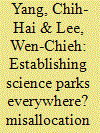| Srl | Item |
| 1 |
ID:
187889


|
|
|
|
|
| Summary/Abstract |
This paper develops a theoretical framework to shed lights on the relations between the segmented financial market and the housing bubble in China. In our framework, capital misallocation across firms plays a central role. The segmented financial market causes discrimination against private enterprises and favoritism to state-owned firms. This biased financial system not only gives rise to capital misallocation across firms but also significantly pushes down the equilibrium interest rate in the formal financial market. The overly low interest rate in the formal financial market causes a rational bubble in a dynamically efficient economy. More importantly, the bubble improves capital allocation across firms by crowding out inefficient investment in the state-owned sector. Despite the role of improving capital allocation, bubbles may still reduce welfare by crowding out aggregate capital.
|
|
|
|
|
|
|
|
|
|
|
|
|
|
|
|
| 2 |
ID:
182752


|
|
|
|
|
| Summary/Abstract |
The establishment of science parks is a vital strategy to develop high-tech industries and facilitate innovations in China. The success of a science park depends heavily on its supportive environment, suggesting that it is hard to replicate everywhere, while China has established many science parks across regions in the past decade. This study evaluates the degree of misallocation in research and development (R&D) and its determinants across science parks in China. Based on an unbalanced panel data of 145 science parks for the period 2007–2014, we find that the overall R&D efficiency has decreased sharply since 2011 when China began to initiate many new science parks. The newly constructed science parks exhibit a lower R&D efficiency than their incumbent parks, suggesting a considerable misallocation in R&D resource caused by expanding science parks everywhere. We further investigate the determinants of R&D misallocation and find that park characteristics and environmental characteristics matter. Parks which are larger, older, and having a higher human quality experience a lower R&D misallocation. Parks with closer R&D collaboration with universities or research institutes, particularly with universities, exhibit a lower R&D misallocation.
|
|
|
|
|
|
|
|
|
|
|
|
|
|
|
|
| 3 |
ID:
182717


|
|
|
|
|
| Summary/Abstract |
The provision of healthcare services and the distribution of medial resources across the China health system hierarchy is characterized by an inverted pyramid with alarming congestions in the so-called AAA tertiary hospitals. This study tries to investigate this baseline misallocation issue prior to the introduction of the new healthcare reforms in 2009. Building upon established framework, we developed an alternative measure for dispersion of factor price distortions. Using a large national microdata, the results obtained are consistent with previous studies in that for a less developed geographical market, often characterized by poorer factor mobility and weaker market competition, dispersion of the factor price distortions is high, reflecting high degree of misallocation. We also developed a decomposition of revenue dispersion to make inferences about the major channels through which the inverted pyramid arises. The analysis reveals the extent to which, the disproportionately large share of revenues generated by high-tier tertiary hospitals in China, can be attributed to their high productivity and the public trusts in them as providers of quality care.
|
|
|
|
|
|
|
|
|
|
|
|
|
|
|
|